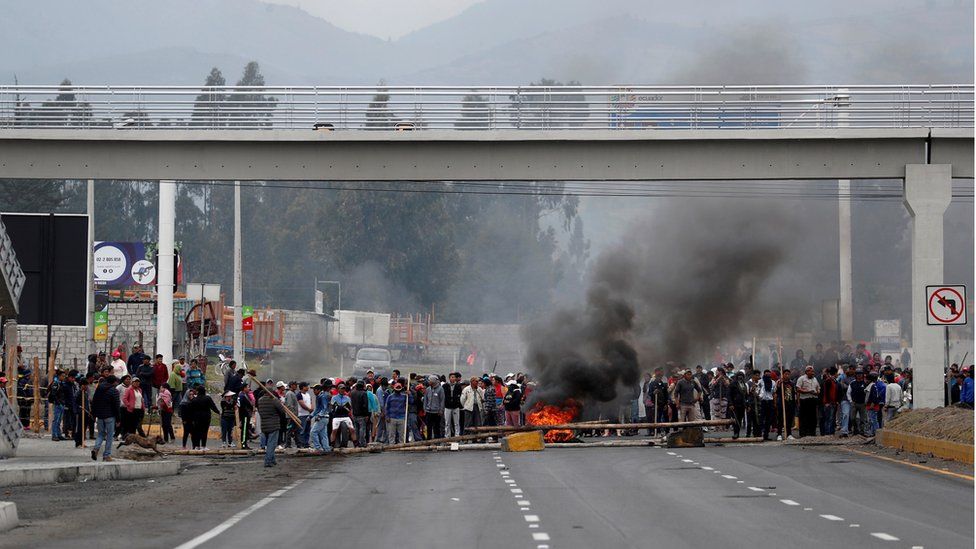Julio José Prado, Minister of Production, reported that during the 18 days of national mobilization there was a preliminary loss of 1,000 million.
After the signing of the agreement between the Government and the indigenous leadership, the government authorities made a final assessment of the emergency that arose from the national strike.
Juan Zapata, director of ECU 911, reported that after the end of the mobilizations, on July 1, 2022, the red alert was canceled and, therefore, the Emergency Operations Committee (COE) was deactivated.
During the 18 days that the protest by social and indigenous organizations lasted, more than 600,000 public order and citizen security emergencies were attended to in the country. These include road closures and crowds.
Zapata also reported that there were more than 100 novelties in the transfer of ambulances, whose mobilization was interrupted, for which land transfers and 29 air transfers had to be made.
Reports by sectors
Transport and public works
Marcelo Cabrera, Minister of Transportation, reported that the MTOP cleared 4,000 kilometers of roads that were closed. The provinces with the greatest difficulties were Sucumbíos, Chimborazo, Cotopaxi and Pastaza.
Once the agreement was signed between the Government and the indigenous leadership, by 6:30 p.m. on June 30, 2022, all roads were cleared. Although some of them were not in perfect condition due to the obstacles that the protesters used for the blockades.
In addition, Cabrera reported that, during the strike, the entity he directs made 40 solidarity flights in collaboration with private airlines. They brought 50 tons of food and medicine to various cities.
Education and inclusion
María Brown, Minister of Education, reported that during the national strike, 4,602 institutions had to work with the distance education modality, out of the more than 16,000 that exist nationwide.
This means that 1.4 million students, that is, 33% of the total, left attendance. The majority were in the Sierra and Amazon, especially in Pichincha, Chimborazo and Azuay.
In addition, during the mobilizations, 575,000 students stopped receiving school meals due to lack of access. And another 194,266 students on the Coast were unable to receive schoolbooks.
As for higher education, 54 universities suspended all classes and 6 partially suspended classes. Likewise, 92 child development centers that serve children under five years of age closed.
Finally, Brown explained that on July 1st, face-to-face classes resumed in the Sierra-Amazonía apart of the country, in which the closing ceremonies of the school year were held.
Work
Patricio Donoso, Minister of Labor, indicated that since July 1st, public servants and private employees returned to face-to-face activities.
During the 18 days of strike, most public servant activities were done through teleworking in the provinces that had protest days, and in the sectors whose activities allow them to work in this way.
Production
Julio José Prado, Minister of Production, presented the preliminary information on the losses due to the mobilizations that lasted 18 days. These exceed those registered in October 2019: this time the protests were longer and more intense.
As of July 1st, $1.0 billion in losses were recorded, with an average of $55 million per day. These values are preliminary because the final pronouncement of the Central Bank is missing. *
The losses are divided as follows:
- $775 million in private activities (local sales and exports).
- $225 million in the oil sector (private and public production).
Among the losses in private activities, one of the hardest hit sectors was the poultry industry, with $30 million. During the strike days, for example, 60 million chickens did not reach their destination.
Other sectors with large losses are the floricultural, dairy and agricultural sectors, with $34 million, $29 million and $90 million in losses, respectively.
* As of July 3rd, this figure is estimated to exceed $1.5 billion.


I don’t understand why you let them get away with shutting down the whole country. With the settlement talks they should have made the demonstrators clean up the roads. It’s ridiculous for .15 cents a gallon you allow businesses and citizens suffer.3 weeks …no food, no travel and murders. Shame on the government to allow it!
I am curious who will submit an accounting of the gains provided by the strike . . .